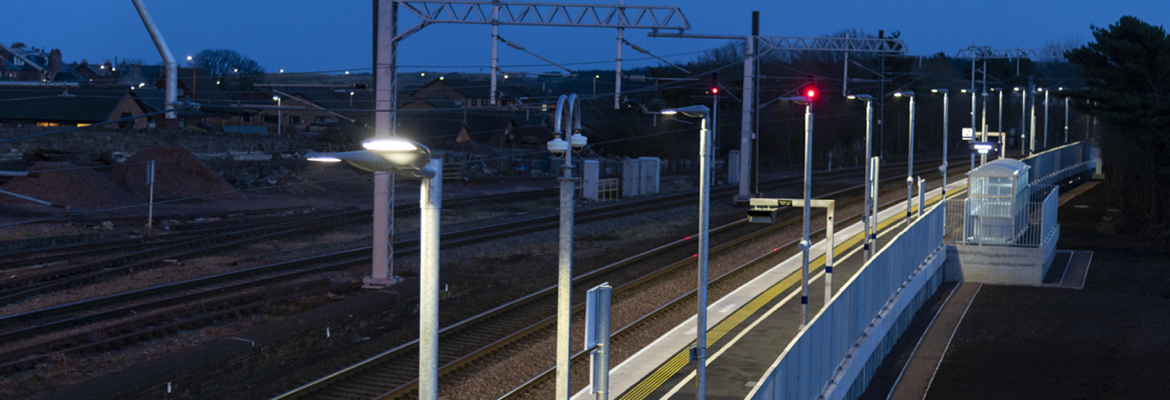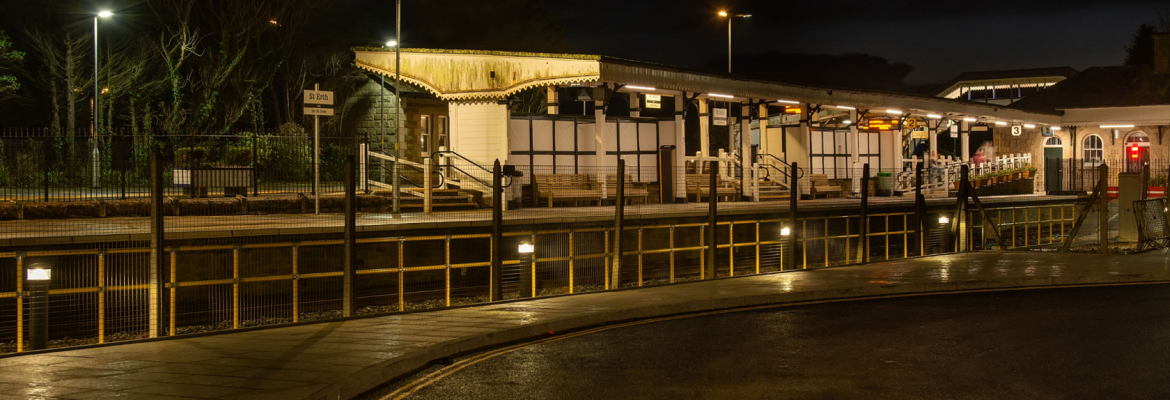How to: light for rail
February 2020
DW Windsor operates internationally. For the best experience in your region, please select the region most applicable to you.
February 2020
Fast paced and efficiency driven, today’s transport network’s main goal is performance (improving capacity and customer experience) and safety. In this ‘How-to’, our rail lighting experts share their observations and knowledge to create a quick guide to rail lighting best practice:
“Open Platform” lighting is typically provided by lanterns mounted on 5m or 6m hinged columns.
Older installations where traditional lamped lighting is being upgraded to LED, often need to retain their existing columns (or the same positions and spacings): which are typically between 10m – 15m.
With newer installations columns can be installed with wider spacings: in excess of 20m is achievable.
This value is dependent on the station usage and footfall from a National Hub Station to small unstaffed stations. It is based on BS EN 12464-2:2014.
Lighting is a significant factor in wayfinding around stations.
Ensure the colour temperature is fit-for-purpose.
4000K is the most widely specified. A high CRI light source should be used especially where CCTV is installed.
Be mindful that modern LED lighting has the potential to incorporate a range of functions – with the ability to be flexible, responsive and controllable to need, where required.
This is a very important consideration when lighting platforms. Any glare needs to be minimised particularly in the driver’s line of sight.
Lighting should clearly look like lighting – extra care should be taken to avoid lighting being mistaken for signals.

Security is of the utmost importance at busy commuter stations, both off-peak and at peak times. Care should be taken to use lighting that supports CCTV cameras (high LOR and CRI). Equipment needs to be positioned to ensure it does not have any detrimental effect on the CCTV footage.
Whilst the energy efficiency of modern LED lighting is improving all the time and is considerably better than older traditional light sources, even higher savings can be made with the use of lighting controls.
Good quality modern LED lighting is very reliable, modern lanterns are rated in excess of 100,000 hours operating life. This can be further enhanced with lighting control and the use of “Constant Light Output” or CLO drivers that automatically compensate for LED lamp degradation over the lifetime of the lantern.
Many stations are located in rural locations; therefore, the prevention of light pollution should be a priority. Flat glass lanterns that operate without the need to be angled are ideal, with bulkhead style lighting avoided. Lighting controls, such as PIR, can also greatly reduce the potential impact of light pollution; lighting only when needed.

If you are looking for simple, smart technology, safety through innovation and considerable energy savings in your rail project, we have a range of solutions available:
PIR
Ideal for platform lighting, we fit PIR’s to dim the lantern in the absence of people being present, in the majority of platform projects that we supply. Typically, the lantern will reduce to 10% or 20% output after a pre-determined time agreed with the client. The time and dimming level can be easily changed if required later, without having to access or open the lantern.
Dimming profiles
Station car parks can be hugely energy intensive, but it is vital that the right light is present when needed. To help lower energy bills but ensure commuters safety, we can supply lanterns with a set dimming profile, allowing them to automatically dim to a lower level at pre-set times (off peak).
Complete control
We offer a wide range of lighting control options from photocells to full Central Management Systems (CMS). We can also supply lighting which can interface with a Building Management System (BMS).
Glare shields
To minimise glare for drivers, our lanterns are designed so Glare Shields can be easily fitted or retrofitted if required.
Emergency luminaires
Emergency luminaires are a must in busy commuter areas. Our post top lanterns and Garda illuminated handrail (for bridges and staircases) can be supplied with integral emergency lighting. We also offer luminaires that are compatible with emergency Uninterrupted Power Supply (UPS) systems.
Heritage luminaires
Not what typically comes to mind when thinking of rail lighting, but many stations have listed status, so to match the architectural requirements we have a range of heritage style lanterns which incorporate modern LED lighting and controls, ideal for use in the rail environment.
Furthermore, for ecologically sensitive areas we are also able to supply lanterns with lower colour temperatures, down to 2700K.
If you would like help with your next rail lighting scheme, contact us here.
Guidance for Platform Lighting is given in the document RIS-7702-INS published by the Rail Safety and Standards Board (RSSB) and further guidance is taken from BS12464-1:2011
GI/RT7016 also deals with the Interface between Station Platforms, Tracks and Trains.
Note: some clients may specify lighting requirements that are different to the levels stated in these documents.